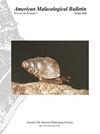Status and Distribution of the Cave-Obligate Land Snails in the Appalachians and Interior Low Plateau of the Eastern United States
IF 0.4
4区 生物学
Q4 MARINE & FRESHWATER BIOLOGY
引用次数: 10
Abstract
Abstract: Cave-obligate (troglobiotic) land snails are among the most understudied taxa inhabiting cave systems because of their small size and cryptic nature. Other than locality records and general descriptions of species' morphology, information regarding most cave snail taxa is minimal. Given the importance of land snails as indicator species and as important drivers of ecosystem processes, this lack of knowledge on cave-obligate taxa impedes conservation management of subterranean snails and subterranean ecosystems in general. As a first step, we compiled and georeferenced all available distributional records for troglobiotic snail species within two major karst regions in the United States: The Interior Low Plateau (ILP) and Appalachians. We identified 16 new localities among these species from caves in Alabama, Tennessee, and Georgia from 2012 to 2016, yielding 8 new occurrences of two species in the ILP and 8 new occurrences of three species in the Appalachians. In total, we report 143 occurrences for five species in 124 caves, representing the most comprehensive dataset on the distribution of caveobligate snails in the eastern United States to date. We also provide the first IUCN Red List conservation assessments for all five troglobiotic taxa and reexamine NatureServe conservation ranks. Our assessments indicate that three of the five species are considered at an elevated risk of extinction. Given these ranks and the threats identified to each species, we offer recommendations concerning the conservation and management of these cave snails and outline future areas of research for these taxa.美国东部阿巴拉契亚山脉和内陆低高原洞穴斜地蜗牛的现状和分布
摘要:洞穴专性陆地蜗牛(troglobiotic)是栖息在洞穴系统中研究最为不足的类群之一,因为它们体积小,性质隐蔽。除了地方记录和物种形态的一般描述外,关于大多数洞穴蜗牛分类群的信息很少。鉴于陆地蜗牛作为指示物种和生态系统过程的重要驱动因素的重要性,对洞穴专性类群的缺乏阻碍了对地下蜗牛和整个地下生态系统的保护管理。作为第一步,我们汇编并地理参考了美国两个主要喀斯特地区:内陆低高原(ILP)和阿巴拉契亚山脉内三球蜗牛物种的所有可用分布记录。从2012年到2016年,我们在阿拉巴马州、田纳西州和佐治亚州的洞穴中确定了16个新的物种位置,在ILP中产生了8个新的两个物种,在阿巴拉契亚山脉中产生了八个新的三个物种。我们总共报告了124个洞穴中五个物种的143次发生,这是迄今为止美国东部洞穴专性蜗牛分布最全面的数据集。我们还提供了第一份世界自然保护联盟红色名录中所有五个三球菌类群的保护评估,并重新审查了NatureServe的保护等级。我们的评估表明,五个物种中有三个被认为面临更高的灭绝风险。鉴于这些等级和对每个物种的威胁,我们提出了关于这些洞穴蜗牛的保护和管理的建议,并概述了这些分类群未来的研究领域。
本文章由计算机程序翻译,如有差异,请以英文原文为准。
求助全文
约1分钟内获得全文
求助全文
来源期刊
CiteScore
1.00
自引率
40.00%
发文量
1
审稿时长
>12 weeks
期刊介绍:
The American Malacological Bulletin serves as an outlet for reporting notable contributions in malacological research. Manuscripts concerning any aspect of original, unpublished research,important short reports, and detailed reviews dealing with molluscs will be considered for publication. Recent issues have included AMS symposia, independent papers, research notes,and book reviews. All published research articles in this journal have undergone rigorous peer review, based on initial editor screening and anonymous reviewing by independent expertreferees. AMS symposium papers have undergone peer review by symposium organizer, symposium participants, and independent referees.

 求助内容:
求助内容: 应助结果提醒方式:
应助结果提醒方式:


